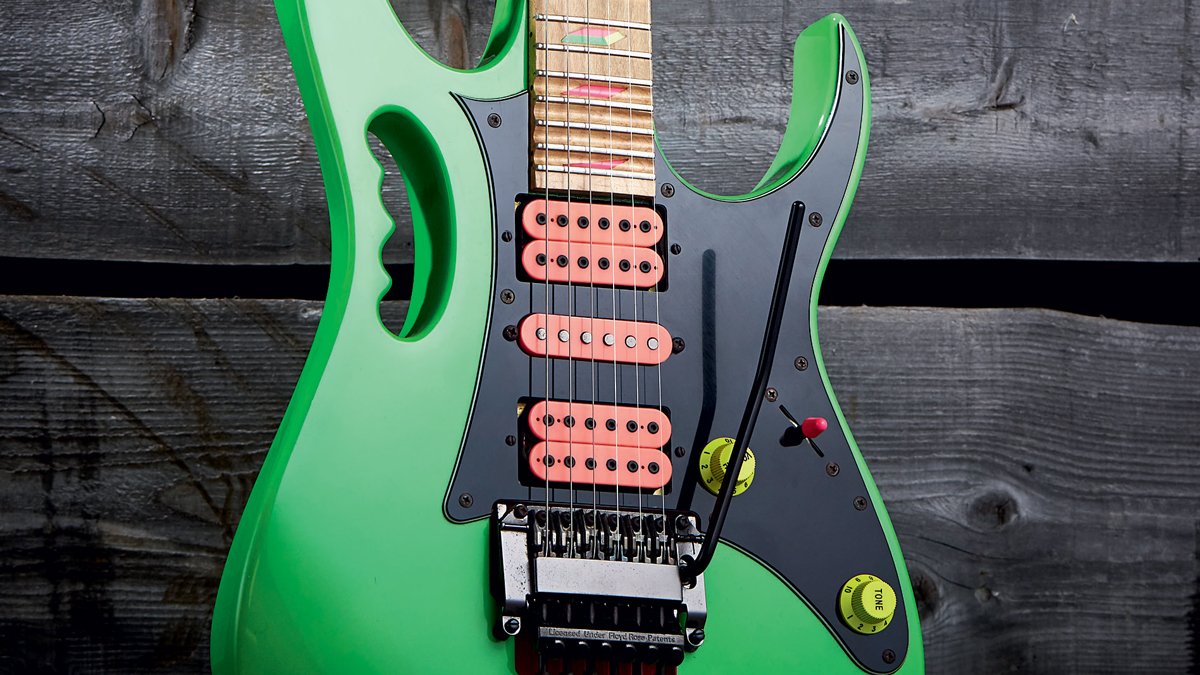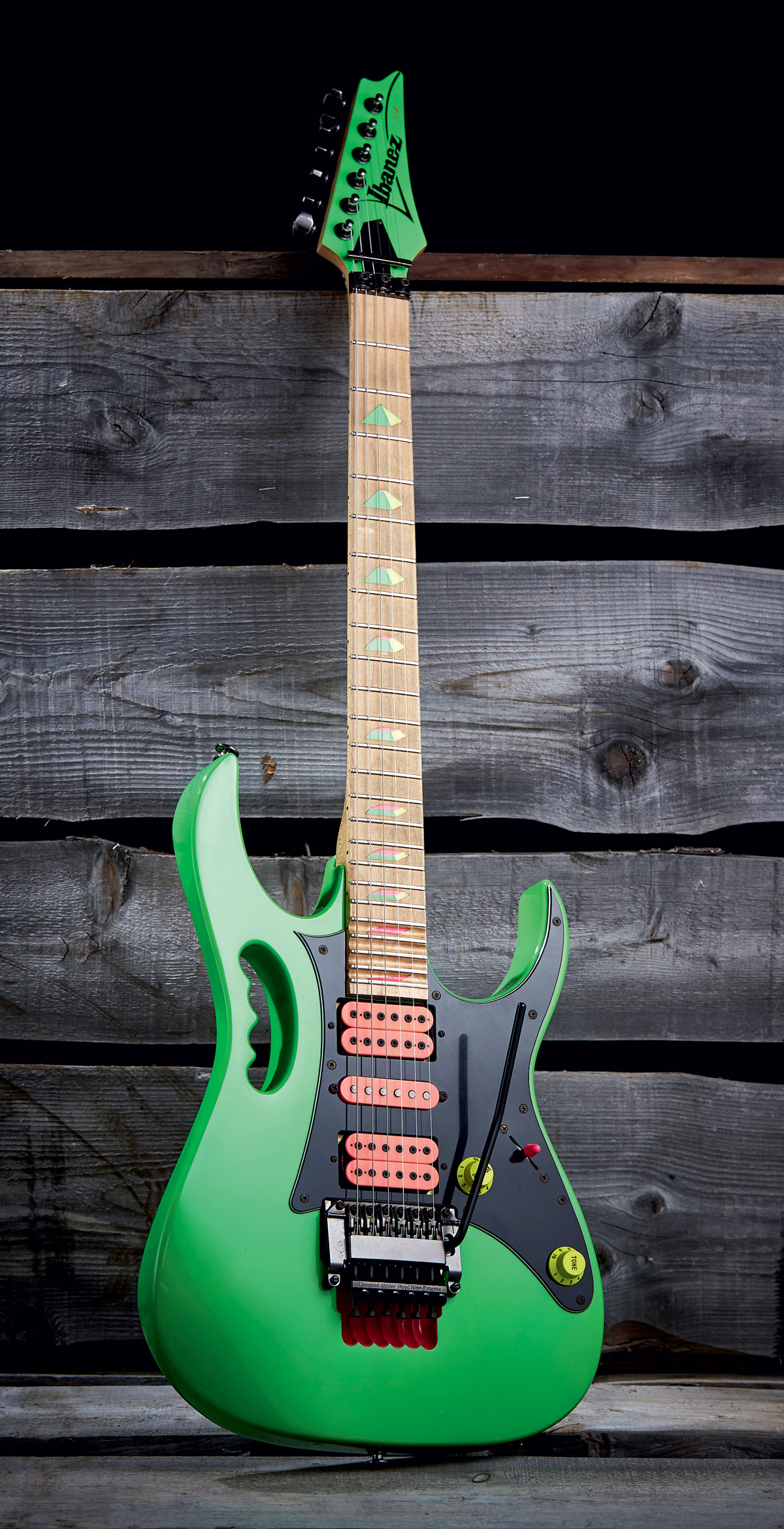The origins of Ibanez and the anatomy of Steve Vai's pioneering JEM
Japanese-made and US-inspired, this hot-rodded solidbody is a modern classic

The Ibanez guitars brand goes back a long way, specifically to late 19th century Spain with luthier Salvador Ibáñez (1854-1920). But it was the American guitar wizard Steve Vai who really put the name on the map with the launch of his now classic JEM signature solidbody at the NAMM Show in 1987.
At the heart of it all is the Japanese Hoshino company who, in 1929, began importing Ibáñez classical guitars soon after the instrument became popular there. Unfortunately, the original Valencian Ibáñez workshop was destroyed in the late 1930s during the Spanish Civil War, at which point Hoshino began making acoustic guitars itself in Japan under the Ibanez brand.
From the late 50s, in the wake of rock ’n’ roll, Hoshino began marketing electric guitars for export and the domestic market under a variety of names, outsourcing production to other Japanese factories in addition to manufacturing its own. Among these instruments were guitars branded Ibanez. In the mid-'60s, Hoshino took the decision to outsource all guitar manufacturing, with the highly respected Fujigen Gakki factory in Matsumoto becoming its main source by the early 70s.
At this point, many Ibanez guitars appeared as distinct copies of other brands’ designs – a move that was encouraged by overseas distributors who saw the potential in high-quality, cheaper alternatives to more established builders such as Gibson and Fender.
In 1972, Hoshino’s Ibanez brand was officially trademarked in the United States while a joint venture ensued with American distributor Elger, enabling the firm’s roots to spread where it mattered the most.
From the late '70s, Ibanez guitars were increasingly spotted in the hands of professional players such as Eddie Van Halen who played a heavily modded Ibanez Destroyer model (inspired by the late-50s Gibson Explorer), while Sylvain Sylvain appeared in the Ibanez Golden Oldie Electric Guitar catalogue playing a Rocket Roll Sr (a cheeky imitation of Gibson’s Flying V).
After Gibson’s owners, Norlin, eventually acquired a trademark for their guitar headstock profiles in 1975, the situation became litigious and Elger ceased using Gibson-style headstock shapes and names. This move effectively encouraged more original Ibanez designs, including the striking Paul Stanley-endorsed Iceman solidbodies.
Get The Pick Newsletter
All the latest guitar news, interviews, lessons, reviews, deals and more, direct to your inbox!
Ibanez expanded its influence as more artists came onboard, including George Benson, Bob Weir and Randy Scruggs who were all honoured with their own signature models.
As the 80s progressed, guitar technique evolved, with Eddie Van Halen popularising the ‘SuperStrat’ style of guitar design synonymous with Kramer, Charvel and Jackson. Ibanez worked hard to keep up with the times, eventually approaching one of the hottest players in the world – Steve Vai – in order to collaborate on a brand-new signature model.
As a discerning guitarist with more than a passing interest in guitar design, Vai began working closely with the team at Ibanez. Before long, the Japanese craftspeople presented him with an instrument that surpassed the guitarist’s expectations. Mysteriously shrouded in black and watched over by a security guard, Ibanez and Vai’s dramatic launch of the JEM777 at the 1987 NAMM Show was met with rapturous applause as the now classic guitar design was unveiled.
Anatomy of the Ibanez JEM

- SERIAL NUMBER: Six digits stamped onto neckplate; first two digits indicate year, eg 87XXXX = 1987; limited edition of 777 instruments hand-signed and numbered by Steve Vai
- HEADSTOCK: Pointed profile; JEM script logo; bold black Ibanez ‘tick’ logo; matching Loch Ness Green finish
- BODY: Stratocaster-style; basswood; offset double-cutaway; forearm, belly and neck joint contours; Monkey Grip handle hole; Lion’s Claw vibrato cavity; Loch Ness Green finish
- PICKUPS & ELECTRONICS: DiMarzio: two DP151 PAF Pro humbuckers (bridge/neck) and DP150 custom single coil (middle); master volume and tone pots; five-way selector switch (positions 2 and 4 split humbucker with middle pickup); side-mounted jack
- HARDWARE: Cosmo Black: six individual Gotoh tuners; single-bar string guide; Top Lok III locking nut; locking bridge two-point Edge vibrato system; two metal strap buttons
- PLASTICS: Black truss rod cover; three-ply (b/w/b) scratchplate; pink switch tip; yellow knobs (marked ‘volume’ and ‘tone’); two black rear control cavity covers
- NECK: Single-piece maple; shallow profile (43mm nut width/19mm deep at 1st fret/21mm deep at 12th fret); 251⁄2-inch scale; maple fretboard; 24 frets (21 to 24 scalloped); 6100 Jim Dunlop fretwire; Disappearing Pyramid coloured fretboard markers
The Evolution of the Ibanez JEM
- December 1986: Steve Vai & Ibanez collaborate
- June 1987: Steve Vai signature JEM777 launched: Loch Ness Green, Desert Sun Yellow & Shocking Pink finishes
- 1988: JEM777 (Desert Sun Yellow, Black) & JEM77FP (Floral Pattern) versions with rosewood/vine inlay ’boards
- 1990: U77 Universe: 7-string Vai signature
- 1996: JEM10TH (10th anniversary): bound ebony/vine ’board, Black finish, engraved metal pickguard
- 1998: JEM90HAM (Hoshino 90th anniversary): ebony ’board, textured blue finish, mirrored scratchplate
- 2000: JEM2KDNA: rosewood/vine ’board, swirl finish made with Vai’s blood
- 2003: JEM-JR aka JEM333: rosewood/dot ’board; budget model
- 2007: JEM20TH (20th anniversary): transparent acrylic body, LED lights, rosewood/vine ’board
- 2017: JEM777 (30th anniversary): reissue of original ’87 model
Rod Brakes is a music journalist with an expertise in guitars. Having spent many years at the coalface as a guitar dealer and tech, Rod's more recent work as a writer covering artists, industry pros and gear includes contributions for leading publications and websites such as Guitarist, Total Guitar, Guitar World, Guitar Player and MusicRadar in addition to specialist music books, blogs and social media. He is also a lifelong musician.
“It holds its own purely as a playable guitar. It’s really cool for the traveling musician – you can bring it on a flight and it fits beneath the seat”: Why Steve Stevens put his name to a foldable guitar
“Finely tuned instruments with effortless playability and one of the best vibratos there is”: PRS Standard 24 Satin and S2 Standard 24 Satin review



![A black-and-white action shot of Sergeant Thunderhoof perform live: [from left] Mark Sayer, Dan Flitcroft, Jim Camp and Josh Gallop](https://cdn.mos.cms.futurecdn.net/am3UhJbsxAE239XRRZ8zC8.jpg)








